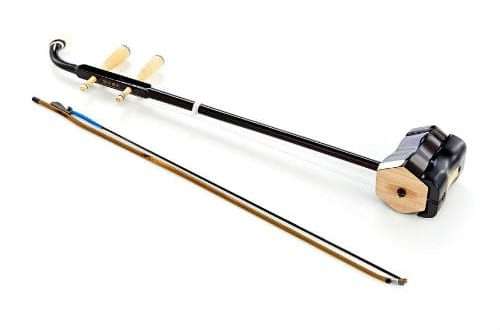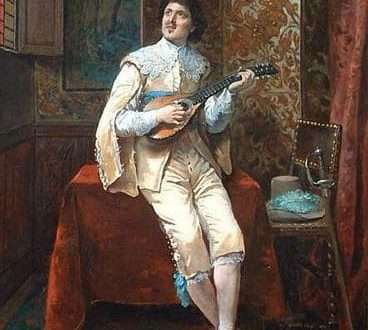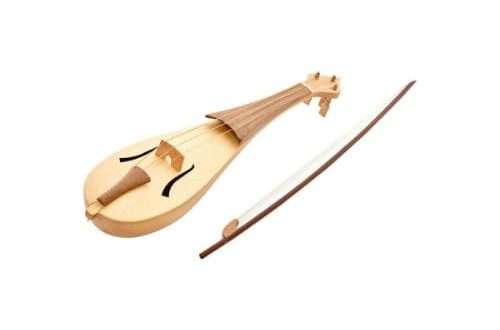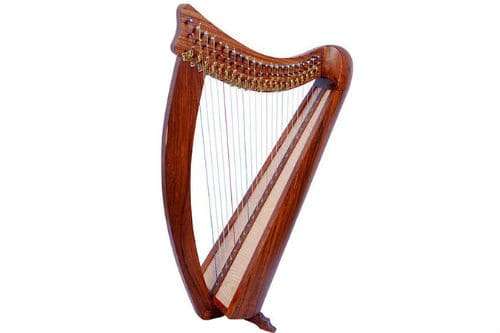
Harp: description of the instrument, composition, sound, history of creation
Contents
The harp is considered a symbol of harmony, grace, tranquility, poetry. One of the most beautiful and mysterious instruments, resembling a large butterfly wing, has provided poetic and musical inspiration for centuries with its soft romantic sound.
What is a harp
A musical instrument that looks like a large triangular frame on which strings are fixed belongs to the plucked string group. This type of instrument is a must-have in any symphonic performance, and the harp is used to create both solo and orchestral music in various genres.

An orchestra usually has one or two harps, but deviations from musical standards also occur. So, in the opera of the Russian composer Rimsky-Korsakov “Mlada” 3 instruments are used, and in the work of Richard Wagner “Gold of the Rhine” – 6.
In most cases, harpists accompany other musicians, but there are solo parts. Harpists solo, for example, in The Nutcracker, Sleeping Beauty and Swan Lake by Pyotr Ilyich Tchaikovsky.
What does a harp sound like?
The sound of the harp is luxurious, noble, deep. There is something extraterrestrial, heavenly in it, the listener has associations with the ancient gods of Greece and Egypt.
The sound of the harp is soft, not loud. The registers are not expressed, the timbre division is vague:
- lower register is muted;
- medium – thick and sonorous;
- high – thin and light;
- the highest is short, weak.
In the harp sounds, there are slight noise shades characteristic of the plucked group. Sounds are extracted by sliding movements of the fingers of both hands without the use of nails.
In harp playing, the glissando effect is often used – the rapid movement of fingers along the strings, due to which a wonderful sound cascade is extracted.
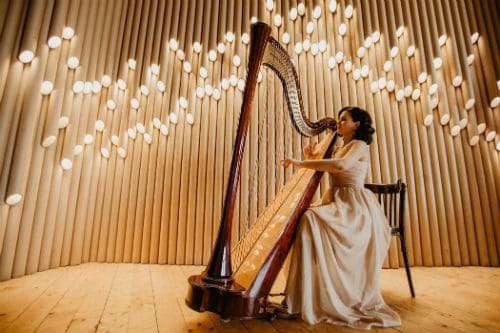
The timbre possibilities of the harp are amazing. Its timbre allows you to imitate the guitar, lute, harpsichord. Thus, in Glinka’s Spanish overture “Jota of Aragon”, the harpist performs the guitar part.
The number of octaves is 5. The pedal structure allows you to play sounds from the contra-octave “re” to the 4th octave “fa”.
Tool device
The triangular tool consists of:
- resonant box about 1 m high, expanding towards the base;
- flat deck, most often made of maple;
- a narrow rail of hardwood, attached to the middle of the soundboard for the entire length, having holes for threading strings;
- a large curved neck in the upper part of the body;
- panels with pegs on the neck for fixing and tuning the strings;
- a front columnar rack designed to resist the vibrations of the strings stretched between the fingerboard and the resonator.
The number of strings for different instruments is not the same. The pedal version is 46-string, with 11 strings made of metal, 35 of synthetic material. And in a small left harp 20-38 lived.
Harp strings are diatonic, that is, flats and sharps do not stand out. And to lower or raise the sound, 7 pedals are used. In order for the harpist to quickly navigate in choosing the right note, multi-colored strings are made. The veins that give the note “do” are red, “fa” – blue.

History of the harp
When the harp appeared is unknown, but the history of its origin goes back to ancient times. It is believed that the progenitor of the tool is an ordinary hunting bow. Perhaps the primitive hunters noticed that the bowstring stretched with different strengths does not sound the same. Then one of the hunters decided to insert a lot of veins into the bow in order to compare their sound in an unusual design.
Each ancient people had an instrument of the original form. The harp enjoyed special love among the Egyptians, who called it “beautiful”, generously decorated it with gold and silver inserts, precious minerals.
In Europe, the compact ancestor of the modern harp appeared in the XNUMXth century. It was used by itinerant artists. In the XNUMXth century, the European harp began to look like a heavy floor structure. Medieval monks and temple attendants used the instrument for musical accompaniment of worship.
In the future, the structure of the instrument was repeatedly experimented, trying to expand the range. Invented in 1660, a mechanism that allows you to change the pitch with the help of tension and release of the strings with the keys was inconvenient. Then in 1720, the German master Jacob Hochbrucker created a pedal device in which the pedals pressed on the hooks that pulled the strings.
In 1810, in France, the artisan Sebastian Erard patented a type of double harp that reproduces all tones. Based on this variety, the creation of modern instruments began.
The harp came to Russia in the XNUMXth century and almost immediately became popular. The first instrument was brought to the Smolny Institute, where a class of harpists was formed. And the first harpist in the country was Glafira Alymova, whose portrait was painted by the painter Levitsky.
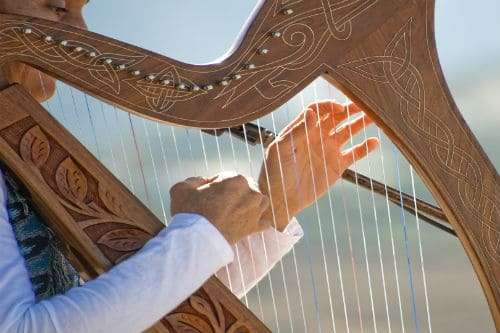
Types
There are the following types of tools:
- Andean (or Peruvian) – a large design with a voluminous soundboard that makes the bass register loud. Folk instrument of the Indian tribes of the Andes.
- Celtic (aka Irish) – a small design. It should be played with her on her knees.
- Welsh – three-row.
- Leversnaya – a variety without pedals. Adjustment is carried out by levers on the peg.
- Pedal – the classic version. The string tension is adjusted by pedal pressure.
- Saung is an arc instrument made by the masters of Burma and Myanmar.
- Electroharp – this is how a variety of a classic product with built-in pickups began to be called.
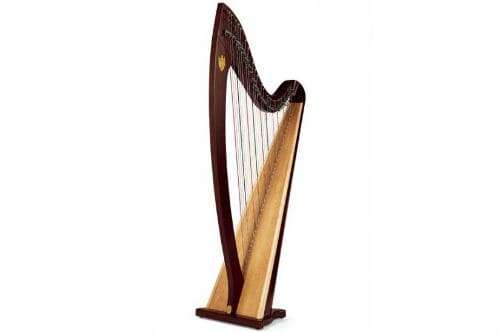
Interesting Facts
The harp has an ancient origin; over the many centuries of its existence, many legends and interesting facts have accumulated:
- The Celts believed that the god of fire and prosperity, Dagda, changes one season of the year for another by playing the harp.
- Since the XNUMXth century, the harp has been part of the state symbols of Ireland. The tool is on the coat of arms, flag, state seal and coins.
- There is an instrument designed in such a way that two harpists can play music simultaneously with four hands.
- The longest Play played by a harpist took over 25 hours. The record holder is American Carla Sita, who at the time of the record (2010) was 17 years old.
- In unofficial medicine, there is a direction of harp therapy, whose adherents consider the sounds of a stringed instrument to be healing.
- A famous harpist was the serf Praskovya Kovaleva, with whom Count Nikolai Sheremetyev fell in love and took her as his wife.
- The Leningrad factory named after Lunacharsky was the first to mass-produce harps in the USSR in 1948.
From antiquity to our time, the harp has been a magical instrument, its deep and soulful sounds enchant, bewitch, and heal. Her sound in the orchestra cannot be called emotional, strong and paramount, but both in solo and in general performance she creates the mood of a musical work.



